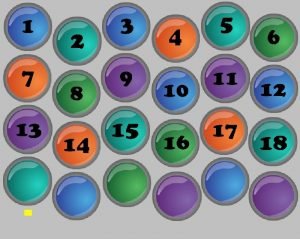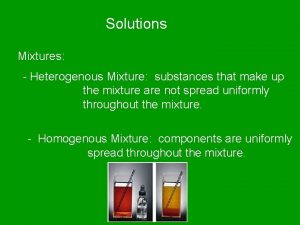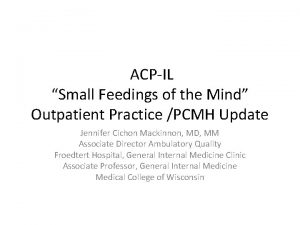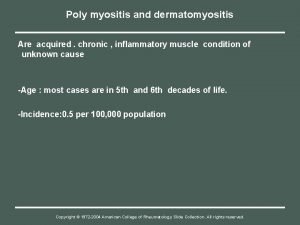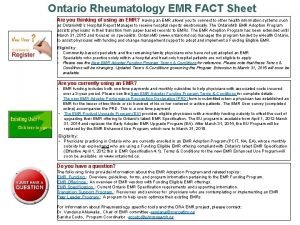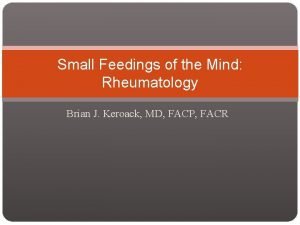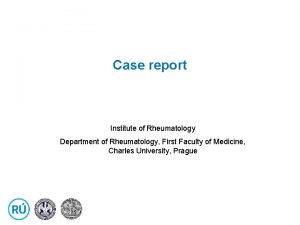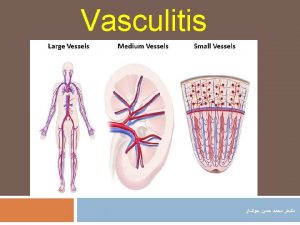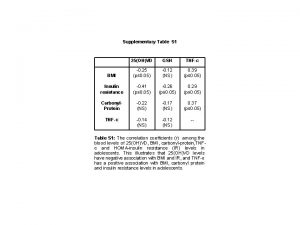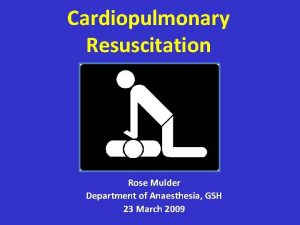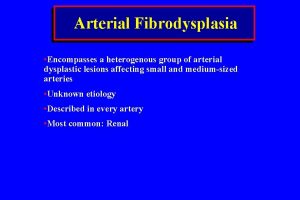VASCULITIDES DANIEL CHIPETA RHEUMATOLOGY GSH VASCULITIDES heterogenous group





















- Slides: 21

VASCULITIDES DANIEL CHIPETA RHEUMATOLOGY GSH

VASCULITIDES heterogenous group of diseases characterised by inflammatory cell infiltration and necrosis of blood vessel wall. Manifestation and severity of vasculitis depends upon the site, type, and location of blood vessels. Vasculitis can be: • primary with no known cause • secondary to underlying disease • pseudovasculitis- procoagulant/thrombogenic states

Histologically, there is inflammation in or through the blood vessel wall, with fibrinoid necrosis or granuloma formation Nomenclature Large vessel vasculitis – aorta and its major tributaries Medium vessel vasculitis –medium and small-sized arteries and arterioles Small vessel vasculitis – small arteries, arterioles, venules and capillaries.

EPIDEMIOLOGY Vasculitides are rare disorders UK studies found primary vasculitides(wegener’s granulomatosis, microscopic polyangiitis, PAN, Churg Strauss Sx) annual incidence of 19. 8 per million Peak age at diagnosis was 65 -74 Male preponderance SA data? Geographical and ethnic differences in incidence of 10 systemic vasculitis

AETIOLOGY EXACT MECHANISMS UNCLEAR WHY LESIONS FOUND IN SPECIFIC VESSELS • ANTIGEN DISTRIBUTED IN DIFF VESSELS • ENDOTHELIAL CELLS ATTRACT INFLAMMATORY CELLS • NONENDOTHELIAL STRUCTURES ARE INVOLVED IN CONTROLLING INFLAM PROCESS

CLASSIFICATION Difficult and confusing becoz of even though there is heterogeneity of vasculitic disrorders there is ; • Overlap in clinical expression of diff vasculitic sx • Evolution of disease over time Most classification use the dominant vessel size and types of blood vessels affected.

Classification of vasculitis Dominant Vessel Primary Secondary Large arteries Giant cell arteritis Takayasu’s arteritis Aortitis assoc with RA Infection – syphilis, TB Medium arteries Classical PAN Kawasaki disease Hep B assoc PAN Small vessels and medium arteries Wegener’s granulomatosis Churg-Strauss syndrome Microscopic polyangiitis Vasculitis secondary to RA SLE, Sjogren’s Syndrome Drugs, Infections(HIV) Small vessels Leucocytoclastic Henoch-Schonlein Purpura, Drugs, Hep C assoc Infection

LARGE VESSEL VASCULITIS Takayasu arteritis – affects aorta and its primary branches. Giant cell(temporal) arteritis – chronic vasculitis of large and medium sized vessels. May be generalised but involves cranial branches of arteries originating from aortic arch. MEDIUM SIZED VESSEL VASCULITIS Polyarteritis nodosa – sytemic necrotizing vasculitis that affects the small and medium-sizeed muscular arteries. When only small vessels are affected, it is called microscopic polyarteritis or polyangiitis

Kawasaki – arteritis of large, medium, and small arteries esp coronary arteries. Isolated central nervous system vasculitis SMALL VESSEL VASCULITIS Churg-Strauss arteritis - aka allergic granulomatosis and angiitis. Vasculitis of medium and small sized muscular arteries. Often found with vascular and extravascular granulomatosis. Involves arteries of skin and lungs and may be generalised.

Wegener’s granulomatosis – systemic vasculitis of medium and small arteries, as well as venules and arterioles. Typically produces granulomatous inflammation of the upper and lower resp tracts and necrotizing, pauciimmune GN. Assoc with ANCA Microscopic polyarteritis – thought to be part of Wegeners. Has ANCA and similar histo changes outside resp tract. Henoch Schönlein Purpura – systemic vasculitis characterised by tissue deposition of Ig A – containing immune complexes in small vessels.

Essential cryoglobulinemic vasculitis – presence of cryoglobulins which are a mixture of immunoglobulins and complement proteins. Precipitate in cold and dissolve upon warming. Often due to Hep C infection IC deposit in vessel wall resulting in small vessel inflammation Hypersensitivity vasculitis Vasculitis to a known or suspected substance eg drug reaction Skin vasculitis with palpable petechiae or purpura Biopsy shows inflammation of small blood vessels called leukocytoclastic vasculitis esp in post capillary venules.

Vasculitis secondary to connective tissue disorders – SLE, RA, Behcets etc. Frequent involves small muscular arteries, arterioles, and venules. Vasculitis secondary to viral infection Hep B and C, HIV, EBV, CMV, Parvo B 19

DIAGNOSTIC APPROACH Establish diagnosis Complaints and signs are nonspecific and include; Fever, fatigue, weakness, arthralgias, abdominal pain, hypertension, acute nephritic sx, and neurologic dysfunction. Suspect a vasculitis when sytemic symptoms occur in combination with single/multi-organ dysfunction(skin, musculoskeletal, renal, git, neurological systems)

History – drugs, hepatitis, disorder assoc with a vasculitis(SLE) Age and sex may be imp in determining a vasculitic syndrome. Exam – determine extent of vascular lesions, distribution of affected organs, presence of additional disease processes(mononeuritis multiplex, palpable purpura are highly suggestive). Lab tests Nonspecific May ascertain type of vasculitis, and degree and types of organs involved

Tests include CEUG, Urinalysis, ESR, LFTs, Viral Serology, CXR, and PFTs, ECG, CSF analysis, Tissue and Blood Cultures, CNS Imaging Specific tests ANA suggest connective tissue disorder, Low complement present in mixed cryoglobulinaemia, and SLE, PR 3(c)ANCA suggest Wegeners granulomatosis, MPO(p)-ANCA favours microscopic polyarteritis EMG if neuromuscular symptoms present and a vasculitis is suspected

Specific tests contd Tissue biopsy – of most clinically involved tissue confirms diagnosis Arteriograms useful in identifying vasculitis of large and medium sized arteries(Takayasu) Categorise a specific vasculitic syndrome Constellation of clinical laboratory, biopsy and radiographic findings usually allows categorisation to a specific syndrome and therapy should be initiated according to this information.

TREATMENT Offending drug should be removed where possible ( eg drug hypersensitivity) Treat underlying disease(infection, neoplasm, CTD) Treatment should be initiated according to category of vasculitic syndrome Broad Principles Glucocoticoids and or immunosuppressive therapy should be instituted immediately in diseases that lead to irreversible organ dysfunction. Longterm use of cyclophosphamide in lupus nephritis prevents ESRD while prednisone alone is less effective.

Steroids Use in conditions not specifically categorised for which there is no standard therapy. Add immunosuppressive only if there is • No adequate response • Remission can be achieved and maintained with toxic doses of steroids Once remission is achieved, taper steroids and discontinue. Usual starting dose is 1 mg/kg/day

Immunosuppressives Cyclophosphamide Drug of choice in Wegeners and severe systemic vasculitides Usual dose 2 mg/kg/day orally Watch for SE – bone marrow suppressio. Dose adjustment based on leucocyte count( >3000/μL), cystitis, bladder ca. Cont Rx for 1 year after induction of remission then taper gradually over months Methotrexate Alternate drug Start at 0. 3 mg/kg once weekly initially

Dose adjustments up to 20 – 25 mg per week and maintain at that level. Azathioprine Dose 2 mg/kg per day Not as effective Cyclosporine MMF Plasmapharesis + immunosupression

REFERENCES 1. Up. To. Date Version 15. 1 2. Braunwald et al. Harrison’s Principles of Internal Medicine 15 th Edition. vol 2. 2001. USA; Mc. Graw-hill. 3. Wegand CM, Goronzy Jorg. Medium and Large Vessel vasculitis. N. Engl J. Med. 2003; 349: 160 -9
 A heterogeneous mixture of intermediate size particles
A heterogeneous mixture of intermediate size particles Heterogeneous team
Heterogeneous team Heterogeneous audience means
Heterogeneous audience means Heterogenous class
Heterogenous class Heterogenous
Heterogenous Solutions are heterogenous mixtures
Solutions are heterogenous mixtures Vbpm rheumatologists
Vbpm rheumatologists Andres quiceno
Andres quiceno Dermatomyositis
Dermatomyositis Rheumatology org
Rheumatology org Gregory gardner md
Gregory gardner md Alberto rios zertuche
Alberto rios zertuche Ps suite emr system requirements
Ps suite emr system requirements Rheumatology mind map
Rheumatology mind map Colin tench rheumatology
Colin tench rheumatology Altruism definition psychology
Altruism definition psychology Within group variance vs between group
Within group variance vs between group Anova within group and between group
Anova within group and between group Classification of social group
Classification of social group Group 1 vs group 2 specialties
Group 1 vs group 2 specialties Thermal stability of group 1 nitrates
Thermal stability of group 1 nitrates Amino group and carboxyl group
Amino group and carboxyl group
